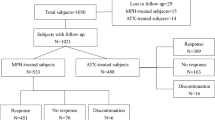Abstract
Methylphenidate (MPH) is psychostimulants used to treat Attention-Deficit/Hyperactivity Disorder and can lead to a long-lasting neurochemical and behavioral adaptations in experimental animals. In the present study, the cerebral antioxidant enzymatic system, superoxide dismutase (SOD) and catalase (CAT) was evaluated at in different age following MPH (1, 2 or 10 mg/kg MPH, i.p.) treatment in young rats. In the acute treatment the SOD activity decreased in the cerebral prefrontal cortex with opposite effect in the cerebral cortex; and the CAT activity decreased in hippocampus. In the chronic treatment the SOD activity increased in the hippocampus and cerebral cortex and decreased in the striatum. The observed changes on the enzyme activities in rat brain were dependent on the structure brain region and duration of treatment with MPH. Probably, the activity of enzymes was not be enough to prevent MPH-induced oxidative damage in specific regions from brain, such as observed for us in another recent study.


Similar content being viewed by others
References
Faraone SV, Sergeant J, Gillberg C, Biederman J (2003) The worldwide prevalence of ADHD: is it an American condition? World Psychiatry 2:104–113
Biederman J (2003) Pharmacotherapy for attention-deficit/hyperactivity disorder (ADHD) decrease the risk for substance abuse: findings from a longitudinal follow-up youths with and without ADHD. J Chem Psychiatry 64(suppl 11):3–8
Swanson JM, Sergeant JA, Taylor E, Sonega-Barke EJ, Jensen PS, Cantwell DP (1998) Attention-deficit hyperactivity disorder and hyperkinetic disorder. Lancet 351:429–433
Bush G, Frazier JA, Rauch SL, Sudman LT, Whalen PJ, Jenike MA et al (1999) Anterior cingulated cortex dysfunction in attention-deficit/hyperactivity disorder revelated by fMRI and the counting stroop . Biol Psychiatry 45:1542–1552
Castellanos FX, Giedd JN, Berquin PC, Walter JM, Sharp W, Tran T, Vaituzis AC, Bastain T, Blumenthal J, Nelson J, Zidenbos A, Evans AC, Rapoport JL (2001) Quantitative brain magnetic resonance imaging in girls with attention-deficit hyperactivity disorder. Arch Gen Psychiatry 58:289–295
Middleton c, Their P (2000) Basal ganglio and cerebellar loops: motor and cognitive circuits. Brain Res Brain Res Rev 31:236–250
Ernest M, Zametkinaj, Matochik JA, Pascualvaca D, Jons PH, Cohen H (1999) High midbrain [18F]DOPA accumulation in children with attention deficit hyperactivity disorder. Am J Psychiatry 156:1209–1215
Girus B, Jaber M, Jones SR, Wightman RM, Caron MG (1996) Hyperlocomotion and indifference to cocaine and amphetamine in mice lacking the dopamine transporter. Nature 379:606–612
Goldman-Rakic PS, Muly EC, Williams GV (2000) D(1) receptors in prefrontal cells circuits. Brain Res Brain Res Rev 31:295–301
Arnstem AFT, Li BM (2005) Neurobiology executive functions: catecholamine influences on prefrontal cortical function. Biol Psychiatry 57:1377–1384
Han DD, Gu HH (2006) Comparison of the monoamine transporters from human and mouse in their sensitivities to psychostimulant drugs. BMC Pharmacol 6:6
Coyle JT (2000) Psychotropic drug use in very young children. JAMA 283:306–311
Benes FM (1998) Brains development VII human brain growth spans decades. Am J Psychiatry 155:1489
Martins MR, Reinke A, Petronilho FC, Gomes KM, Dal-Pizzol F, Quevedo J (2006) Methylphenidate treatment induces oxidative stress in early developmental rat brain. Brain Res 1078:189–197
Fagundes AO, Rezin GT, Zanette F, Grandi E, Assis L, Dal-Pizzol F, Quevedo J, Streck E (2007) Chronic administration of methylphenidate actives mitochondrial respiratory chain in brain of young rats. Int J Dev Neurosci 25:47–51
Bannister JV, Claberese L (1987) Assays for superoxide dismutase. Methods Biochem Anal 32:279–231
Dal-Pizzol F, Klamt F, Bernard EA, Benfato MS, Moreira JCF (2001) Retinol supplementation induces oxidative stress and modulates antioxidant enzyme activities in rat sertoli cells. Free Radic Res 34:395–404
Lowry OH, Rosebrough AL, Randal RJ (1951) Protein measurement with the folin phenol reagent. J Biol Chem 193:265–275
Davies KJ (1995) Oxidative stress: the paradox of aerobic life. Biochem Soc Symp 61:1–31
Floyd RA (1999) Antioxidants, oxidative stress and degenerative neurological disorders. Proc Soc Exp Biol Med 222(3):236–245
Sandoval V, Riddle EL, Hanson GR, Fleckenstein AE (2002) Methylphenidate redistributes vesicular monoamine transporter-2: role of dopamine receptors. J Neurosci 22:8705–8710
Williams SM, Goldman-Rakic PS (1998) Widespread origin of the primate mesofrontal dopamine system. Cereb Cortex 8:321–245
Author information
Authors and Affiliations
Corresponding author
Rights and permissions
About this article
Cite this article
Gomes, K.M., Petronilho, F.C., Mantovani, M. et al. Antioxidant Enzyme Activities Following Acute or Chronic Methylphenidate Treatment in Young Rats. Neurochem Res 33, 1024–1027 (2008). https://doi.org/10.1007/s11064-007-9544-1
Received:
Accepted:
Published:
Issue Date:
DOI: https://doi.org/10.1007/s11064-007-9544-1




